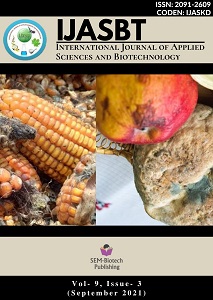Integrated Nutrient Management (INM) in Soil and Sustainable Agriculture
DOI:
https://doi.org/10.3126/ijasbt.v9i3.39275Keywords:
INM , concepts, components, sustainable agricultureAbstract
The world vision of no hunger target, food security, and zero poverty followed by raising standards of living of rural people through agricultural transformation is the greatest challenges faced by the agricultural planners worldwide. Due to the alarming state of population growth and cultivable land scarcity, change in agronomic practices which could bring a significant effect on crop production and productivity is urgently needed. The concept of using different sources of plant nutrients combined to check nutrient depletion, maintain soil health, and crop productivity, called INM, has a bright solution in this area. Recently several researchers introduced that integrated use of inorganic fertilizers, organic fertilizers, green manure, and bio-fertilizers is becoming an effective practice not only for increasing crop production and productivity but also for the better crop and soil health. In addition, INM helps to increase the activity of soil microorganisms and improves the soil physical, chemical and biological properties. So, INM create an economic eco-friendly environment by reducing the dependence on inorganic chemical fertilizers and improving the soil fertility, optimizing crop yield, maximizing profitability and ultimately making the agriculture sustainable. Lastly, INM is one of the good agricultural practices which needs to be followed by every conscious individual in order to maintain soil health, nutrient balance and to make the agriculture and environment more sustainable.
Int. J. Appl. Sci. Biotechnol. Vol 9(3): 160-165
Downloads
Downloads
Published
How to Cite
Issue
Section
License
Copyright (c) 2021 International Journal of Applied Sciences and Biotechnology

This work is licensed under a Creative Commons Attribution-NonCommercial 4.0 International License.




